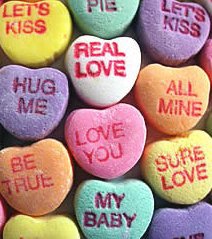 [[S Y M B O L S]] * Since today is Valentine’s Day, it seems only right to comment on affairs of the heart. Or, in the case of Slate, to get right to the heart of the matter that matters most on this occasion, and ask that burning question: “How did the heart shape become the symbol of true love?” According to Washington, D.C., writer Keelin McDonell, there’s no definitive answer,
[[S Y M B O L S]] * Since today is Valentine’s Day, it seems only right to comment on affairs of the heart. Or, in the case of Slate, to get right to the heart of the matter that matters most on this occasion, and ask that burning question: “How did the heart shape become the symbol of true love?” According to Washington, D.C., writer Keelin McDonell, there’s no definitive answer,but it might have to do with a North African plant. During the seventh century B.C., the city-state of Cylene had a lucrative trade in a rare, now-extinct plant: silphium. Although it was mostly used for seasoning, silphium was reputed to have an off-label use as a form of birth control. The silphium was so important to the Cylenian economy that coins were minted that depicted the plant’s seedpod, which looks like the heart shape we know today. The theory goes that the heart shape first became associated with sex, and eventually, with love.On the other hand, McDonell notes, the Catholic Church says that the modern heart shape (which bears only a passing resemblance, it seems, to an actual human heart) originated during the 17th century, “when Saint Margaret Mary Alocoque had a vision of it surrounded by thorns. This symbol became known as the Sacred Heart of Jesus and was associated with love and devotion; it began popping up often in stained-glass windows and other church iconography.”
The practice of exchanging Valentine’s Day greetings apparently became prevalent in England during the 1600s, and the tradition was imported to the United States during the 19th century. It was also in the 1800s that the first mass-produced Valentine’s Day cards of embossed paper lace were made and sold--reportedly the creation of a Worchester, Massachusetts, woman named Esther Howland, who was inspired by an English valentine she had been given. According to the Hallmark Company, 192 million Valentine’s Day cards are now exchanged annually, making this the second-most popular occasion for gift-card giving (after Christmas). It’s anybody’s guess how many heart-shaped chocolates, conversation hearts, heart-shaped balloons, and cakes in the familiar form of a heart are dispensed and consumed on this day every year. But it’s certainly enough to keep the hearts of American commerce beating.
READ MORE: “The History of Valentine’s Day” (The History Channel).







No comments:
Post a Comment